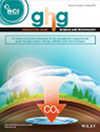Azizbek Kamolov, Zafar Turakulov, Adham Norkobilov, Miroslav Variny, Marcos Fallanza
求助PDF
{"title":"乌兹别克斯坦陆上二氧化碳储存和利用区域资源评价和分布","authors":"Azizbek Kamolov, Zafar Turakulov, Adham Norkobilov, Miroslav Variny, Marcos Fallanza","doi":"10.1002/ghg.2325","DOIUrl":null,"url":null,"abstract":"<div>\n \n <p>Addressing the escalating threat of climate change requires a global response, with significant actions from every nation. Uzbekistan, a member of the Paris Agreement, is actively pursuing sustainable development by reducing greenhouse gas emissions and promoting renewable energy. However, the country's Green Economy strategies currently lack Carbon Capture, Storage, and Utilization (CCUS) technology. A feasibility assessment is crucial to evaluating CCSU's potential for achieving net-zero emissions, benefiting both the public and scientific communities by informing policy decisions, and providing valuable data. The primary aim of this study is to evaluate Uzbekistan's potential for carbon dioxide (CO<sub>2</sub>) storage and utilization (CSU) in the near and mid-term. To achieve this, this work proposes a methodology for efficient CO<sub>2</sub> source-sink matching to facilitate the deployment of CCUS technologies in Uzbekistan. Resource evaluation and spatial analysis methods are used to estimate the total CSU capacity of the region and the geographical distribution of CO<sub>2</sub> sources in two large-scale emitting sectors, specifically from the power and cement plants. According to the results, Uzbekistan has an annual CSU capacity of 1171 million tons CO<sub>2</sub>, which is several times higher than the annual CO<sub>2</sub> emission rate. Additionally, CSU resources are primarily located in the eastern, western, and southern regions of the country, whereas CO<sub>2</sub> sink locations near the capital city and its surrounding areas are limited compared to their abundance of CO<sub>2</sub> sources. Overall, although the country has ample CO<sub>2</sub> storage capacity for CCUS deployment, the prospects for its chemical utilization remain limited in scale. © 2025 Society of Chemical Industry and John Wiley & Sons, Ltd.</p>\n </div>","PeriodicalId":12796,"journal":{"name":"Greenhouse Gases: Science and Technology","volume":"15 2","pages":"126-141"},"PeriodicalIF":2.8000,"publicationDate":"2025-02-11","publicationTypes":"Journal Article","fieldsOfStudy":null,"isOpenAccess":false,"openAccessPdf":"","citationCount":"0","resultStr":"{\"title\":\"Regional Resource Evaluation and Distribution for Onshore Carbon Dioxide Storage and Utilization in Uzbekistan\",\"authors\":\"Azizbek Kamolov, Zafar Turakulov, Adham Norkobilov, Miroslav Variny, Marcos Fallanza\",\"doi\":\"10.1002/ghg.2325\",\"DOIUrl\":null,\"url\":null,\"abstract\":\"<div>\\n \\n <p>Addressing the escalating threat of climate change requires a global response, with significant actions from every nation. Uzbekistan, a member of the Paris Agreement, is actively pursuing sustainable development by reducing greenhouse gas emissions and promoting renewable energy. However, the country's Green Economy strategies currently lack Carbon Capture, Storage, and Utilization (CCUS) technology. A feasibility assessment is crucial to evaluating CCSU's potential for achieving net-zero emissions, benefiting both the public and scientific communities by informing policy decisions, and providing valuable data. The primary aim of this study is to evaluate Uzbekistan's potential for carbon dioxide (CO<sub>2</sub>) storage and utilization (CSU) in the near and mid-term. To achieve this, this work proposes a methodology for efficient CO<sub>2</sub> source-sink matching to facilitate the deployment of CCUS technologies in Uzbekistan. Resource evaluation and spatial analysis methods are used to estimate the total CSU capacity of the region and the geographical distribution of CO<sub>2</sub> sources in two large-scale emitting sectors, specifically from the power and cement plants. According to the results, Uzbekistan has an annual CSU capacity of 1171 million tons CO<sub>2</sub>, which is several times higher than the annual CO<sub>2</sub> emission rate. Additionally, CSU resources are primarily located in the eastern, western, and southern regions of the country, whereas CO<sub>2</sub> sink locations near the capital city and its surrounding areas are limited compared to their abundance of CO<sub>2</sub> sources. Overall, although the country has ample CO<sub>2</sub> storage capacity for CCUS deployment, the prospects for its chemical utilization remain limited in scale. © 2025 Society of Chemical Industry and John Wiley & Sons, Ltd.</p>\\n </div>\",\"PeriodicalId\":12796,\"journal\":{\"name\":\"Greenhouse Gases: Science and Technology\",\"volume\":\"15 2\",\"pages\":\"126-141\"},\"PeriodicalIF\":2.8000,\"publicationDate\":\"2025-02-11\",\"publicationTypes\":\"Journal Article\",\"fieldsOfStudy\":null,\"isOpenAccess\":false,\"openAccessPdf\":\"\",\"citationCount\":\"0\",\"resultStr\":null,\"platform\":\"Semanticscholar\",\"paperid\":null,\"PeriodicalName\":\"Greenhouse Gases: Science and Technology\",\"FirstCategoryId\":\"93\",\"ListUrlMain\":\"https://scijournals.onlinelibrary.wiley.com/doi/10.1002/ghg.2325\",\"RegionNum\":4,\"RegionCategory\":\"环境科学与生态学\",\"ArticlePicture\":[],\"TitleCN\":null,\"AbstractTextCN\":null,\"PMCID\":null,\"EPubDate\":\"\",\"PubModel\":\"\",\"JCR\":\"Q3\",\"JCRName\":\"ENERGY & FUELS\",\"Score\":null,\"Total\":0}","platform":"Semanticscholar","paperid":null,"PeriodicalName":"Greenhouse Gases: Science and Technology","FirstCategoryId":"93","ListUrlMain":"https://scijournals.onlinelibrary.wiley.com/doi/10.1002/ghg.2325","RegionNum":4,"RegionCategory":"环境科学与生态学","ArticlePicture":[],"TitleCN":null,"AbstractTextCN":null,"PMCID":null,"EPubDate":"","PubModel":"","JCR":"Q3","JCRName":"ENERGY & FUELS","Score":null,"Total":0}
引用次数: 0
引用
批量引用




 求助内容:
求助内容: 应助结果提醒方式:
应助结果提醒方式:


